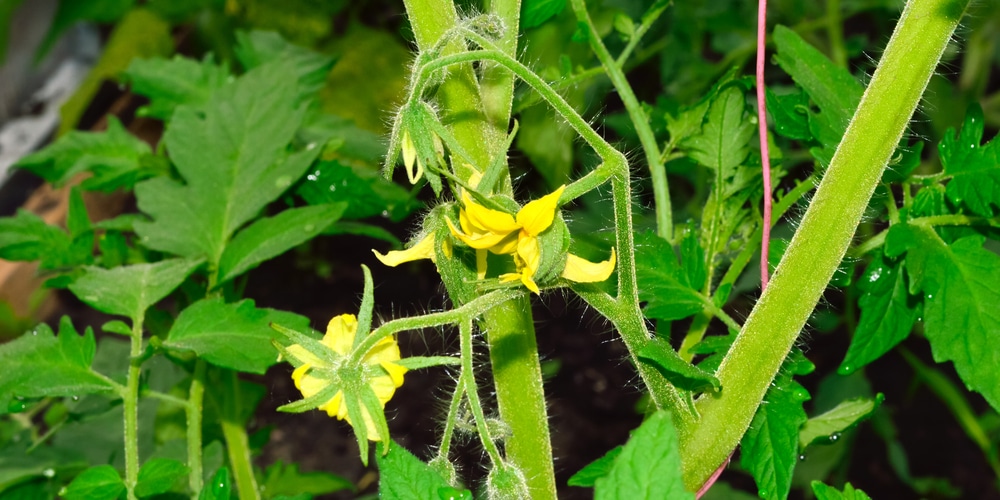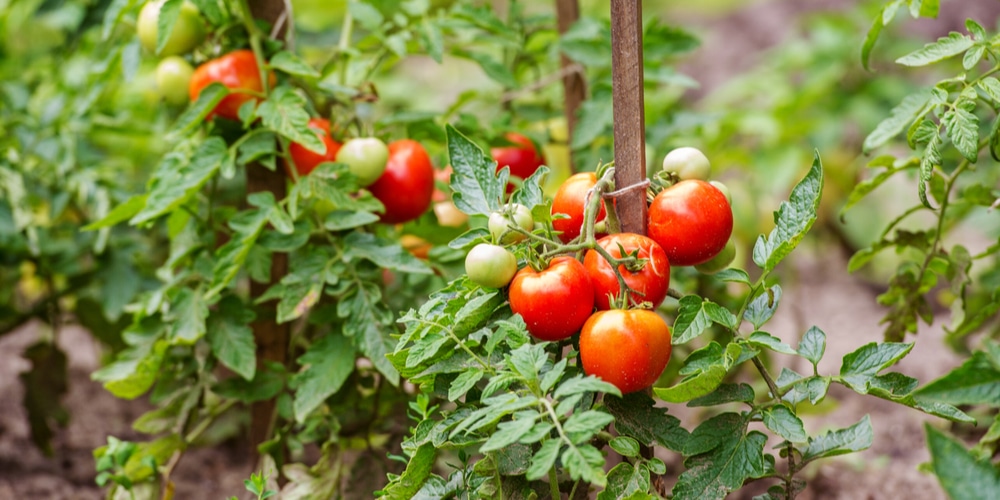Growing tomatoes is very popular with gardeners across America, as the fruits are relatively easy to grow and taste great. Tomatoes are very versatile and can be used in various hot and cold dishes. If you’re looking for ow to get thick stems on your tomato plants, you’ve come to the right place!
To ensure you get a successful crop of tomatoes, you’ll need to look after your plants so that they are healthy, have thick stems, and can produce fruit. Tomatoes need the right soil pH and growing conditions. If you need to increase your tomato PH level, a great way to do so is with lime. Just don’t add too much lime to tomatoes, it can hurt them. They like a PH of about 6.0 to 6.5.
They also need to be watered regularly and kept free from insect infestation.
Let’s look at how to get thick steams on tomato plants.
How to Grow Tomatoes With Thick Stems

When well cared for, tomato plants will have thick, green, and healthy stems to support the growth of the fruit. Sometimes a tomato plant’s stem won’t grow as well and will look thin due to several factors. If a plant gets insufficient sunlight, isn’t watered correctly, or lacks nitrogen, the steam won’t grow to be thick and healthy. Here are some tips to growing healthy tomatoes with thick steams:
Grow Tomatoes from Seeds
It’s best to grow tomatoes from seeds rather than buying seedlings. This will allow you to ensure that they have a good start in life. The best time of year to plant tomatoes from the seed is in the early spring in nursery beds and then transplant the young seedlings after six weeks. Ensure your plants are adequately spaced when transplanting as they won’t grow well if they’re too close together and competing for nutrients.
Tomatoes grow best in a sunny spot and don’t do well in full shade. If you plan to grow your tomatoes in pots, you can use potting soil. Please make sure the pots have drainage holes in the bottom so that they don’t become waterlogged.
Support Your Tomato Plants
Tomato plants climb as they grow taller and require support from bamboo poles. Don’t let your plants grow along the ground, or they will be prone to disease and will be more likely to be eaten by pests such as slugs, snails, cutworms, mice, or squirrels.
Mulching
It’s a good idea to mulch tomato plants with straw as this helps to hold moisture in the soil. Tomatoes need to be watered frequently, and mulch can reduce the amount of water that evaporates. Mulching also stops weeds from growing and adds nutrients to the soil.
Pruning
Once the tomato plants get tall, you can prune the lower leaves. Often when the bottom leaves are left on the tomato plant, they become rotten as rainwater drips down the plant. Rot can spread to leaves further up the plant and can eventually kill your tomato plants.
Watering Tomatoes
Once you’ve transplanted your tomato seedlings, you should water them daily. Tomato seedling can easily die of dehydration, especially if you live in a hot, dry climate. It’s best to water the plants in the morning, as water drops on the stem or leaves won’t scorch the plant, as they would during the hottest part of the day. Also, less water will be lost due to evaporation during the early morning.
Once the young seedlings have established their rooting system and started to grow, you can slightly reduce watering frequency. Larger tomato plants require water three times a week. Ensure that you provide plenty of water so that it soaks deep into the soil. This will help your tomato plant grow a strong stem and strong deep roots.
Fertilizing Tomatoes
Once you’ve transplanted your seedlings, you can help them grow a strong, thick stem by applying starter fertilizer. This will also help the young plants establish a robust rooting system. You can use compost specifically designed for growing tomatoes, as this will have all the nutrients the plants need. You may also like to apply an organic or chemical fertilizer twice a month.
Crop Rotation
Rotating the crops in your vegetable plot annually is very important as it stops the soil from becoming deficient in nutrients. If you were to grow tomatoes in the same place every year, the nutrient the tomatoes need to grow healthy would soon become exhausted, and you’d end up with thinner, less healthy plants.
The best thing to do is plant legumes in the spot that you grew tomatoes in last year, as these plants provide the soil with nitrogen. Nitrogen is one of the most critical nutrients for tomatoes.
Protect Your Tomato Plants from Diseases
Tomato plants are susceptible to many diseases, fungal infections and can also be attacked by pests. These things can all weak your tomato plants and cause them to have thin stems and ultimately grow less fruit.
Aphids
Aphids, also known as greenfly can cause massive damage if your plants become invaded. Aphids live in clusters on the leaves’ surfaces and feed on sap which they suck from the leaves. You can use insecticidal soap on your tomato plants to get rid of these pests.
Cutworms
Another common pest that affects tomatoes is cutworms. These are tiny black worms that hide in the soil and come out at night to feed on the plants. They can cause tomato plant stems to break. Sprinkle some cornmeal on affected tomato plants as this will kill the cutworms.
Whiteflies
Whiteflies are another common pest that feed in a similar way to aphids. They are recognizable as they look white and will turn cause yellowing on plants. They can be controlled with insecticidal soap.
Bacterial Wilt
Bacterial wilt is a disease that can affect tomato plants. The bacteria can live on the soil for many years and affect your crop annually. This makes the disease challenging to get rid of. It’s a good idea only to use certified seeds and practice crop rotation to avoid bacterial wilt.
Leaf Mold
Leaf mold is also a bacterial disease that affects tomatoes and causes them to turn yellow. The disease can affect the plant’s stem and may even kill the plant. When watering your tomatoes, you should try to avoid getting the leaves wet. If your plants are affected, you can treat them with a fungicide.
Slugs and Snails
Slugs and snails are known to eat tomato plants as well.
Conclusion
If you’re looking to grow tomato plants that are healthy, have thick stems, and produce plenty of fruit, you’ll need to take good care of your plants. It’s best to grow the plants from seeds, provide adequate water, fertilize regularly, take care of them in the winter time, and protect your plants from pests and fungal infections.
